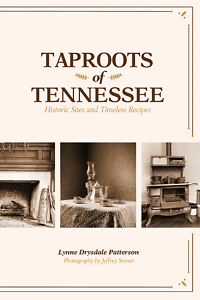A Taste of Tennessee’s History
Taproots of Tennessee is equal parts history, cookbook, and travel guide
In 2010, songwriter Lynne Drysdale Patterson saw an unexpectedly life-changing film — not a blockbuster or a heartwarming biopic, but a video to promote tourism called Discover Tennessee Trails and Byways. The film, she writes in Taproots of Tennessee, showcased the state’s “grand divisions — East, Middle, and West, with their rugged terrain and trails trodden into rural, scenic back roads and winding highways.” Patterson was inspired that day to pen the lyrics that became her award-winning song, “Trails of Tennessee,” and she ultimately embarked on the research that informs Taproots.
 “I wanted to travel these byways leading to Tennessee’s small historic towns,” writes Patterson, a member of two chapters of the Daughters of the American Revolution. And so she did, visiting 17 historical sites across the state to gather material for the book, which reaches across genres to deliver historical narrative, travel information, and recipes from each place. In Patterson’s words, “Rather than an exhaustive study on the lives and times of each site’s inhabitants, this book presents a condensed, albeit insightful, portrait of Tennessee’s pioneering families, their place in our state’s history, and the foods that sustained them.”
“I wanted to travel these byways leading to Tennessee’s small historic towns,” writes Patterson, a member of two chapters of the Daughters of the American Revolution. And so she did, visiting 17 historical sites across the state to gather material for the book, which reaches across genres to deliver historical narrative, travel information, and recipes from each place. In Patterson’s words, “Rather than an exhaustive study on the lives and times of each site’s inhabitants, this book presents a condensed, albeit insightful, portrait of Tennessee’s pioneering families, their place in our state’s history, and the foods that sustained them.”
Each chapter showcases a particular site’s distinct personality, offering details on its founding, the story of its construction/architecture, and a brief narrative of the people who worked its land. Practical information about planning a visit serves as a bridge from the narrative section to the recipe section, which consists of a menu based on Patterson’s extensive research on period-appropriate foodways and methods.
For example, the chapter on the Sam Houston Schoolhouse State Historic Site in Maryville begins with a poignant quote from the famous Tennessean: “While teaching in this one-room schoolhouse as a boy of 18, I experienced a higher feeling of dignity and self-satisfaction than from any office or honor which I have held since.” Patterson immerses readers in the history of the schoolhouse since 1794, details about Houston’s family, and the story of Sam running away at age 16 to live with the Cherokee. She then delivers a menu for a meal Sam’s mama might have made him, with recipes for sea biscuits (a.k.a. hard tack), ramp salad, fried meat pies, and wild blackberry cobbler.
 President James K. Polk’s ancestral home in Maury County sits on land the president’s family received as payment for survey work his father, Samuel Polk, did in the early 1800s. Patterson’s narrative outlines the president’s rise to power and his move to Washington, where his patriotic sacrifices included giving up regular consumption of his favorite food, cornpone, in deference to the White House’s French chef (who was hired during the presidency of Thomas Jefferson). Though the Polks’ enslaved cook, Coakley, traveled with them to the White House, the first family’s regular fare included potage crème d’asperge, chicken croquettes with bechamel sauce, and snowball potatoes.
President James K. Polk’s ancestral home in Maury County sits on land the president’s family received as payment for survey work his father, Samuel Polk, did in the early 1800s. Patterson’s narrative outlines the president’s rise to power and his move to Washington, where his patriotic sacrifices included giving up regular consumption of his favorite food, cornpone, in deference to the White House’s French chef (who was hired during the presidency of Thomas Jefferson). Though the Polks’ enslaved cook, Coakley, traveled with them to the White House, the first family’s regular fare included potage crème d’asperge, chicken croquettes with bechamel sauce, and snowball potatoes.
Pan-fried crappie, okra cakes, and pecan pie bread pudding are on the menu for the Alex Haley Home and Interpretive Center in Henning. The Pulitzer Prize-winning author’s childhood home, then called the Palmer house, “was built in 1918 by four African American master carpenters” under the direction of Haley’s grandfather, lumber mill owner William Palmer. Haley, Patterson tells us, treasured many things about this home, including listening to his grandmother’s stories on the porch swing and hiding in the honeysuckle vines. But Haley’s favorite place was in the center of the culinary magic: “The kitchen is one of the most precious places to me. My seat was the window ledge. I sat with my back to the window facing the work table upon which my grandmother prepared foods.”
Burra Burra Mine stretches across Tennessee, Georgia, and North Carolina. What early prospectors incorrectly thought to be gold turned out to be land rich in copper, which lured immigrant workers from Europe to join the Cherokee people who remained on their ancestral land after the Indian Removal Act in 1838. This influx of immigrants brought with them their denominational affiliations, which were set aside one Sunday annually for a communal church picnic. Patterson details the site’s complex story, which is reflected in the diversity of a mock picnic menu featuring Austrian verhackert, Italian angel eggs, and Appalachian shepherd pie.
These brief examples barely scratch the surface of the rich history in Taproots of Tennessee. Patterson surveys the tables of fine homes like Cragfont, Hawthorne Hill, Sabine Hill, and Wynnewood, and she also explains how to make buffalo meatloaf like a pioneer. The book offers readers a tour through Tennessee’s historic places without ever leaving home — though they might well find themselves planning a trip before the end.

Sarah Carter is a veteran high school English teacher working at Vanderbilt Writing Studio. She holds an M.F.A. in creative writing from the Sewanee School of Letters.


